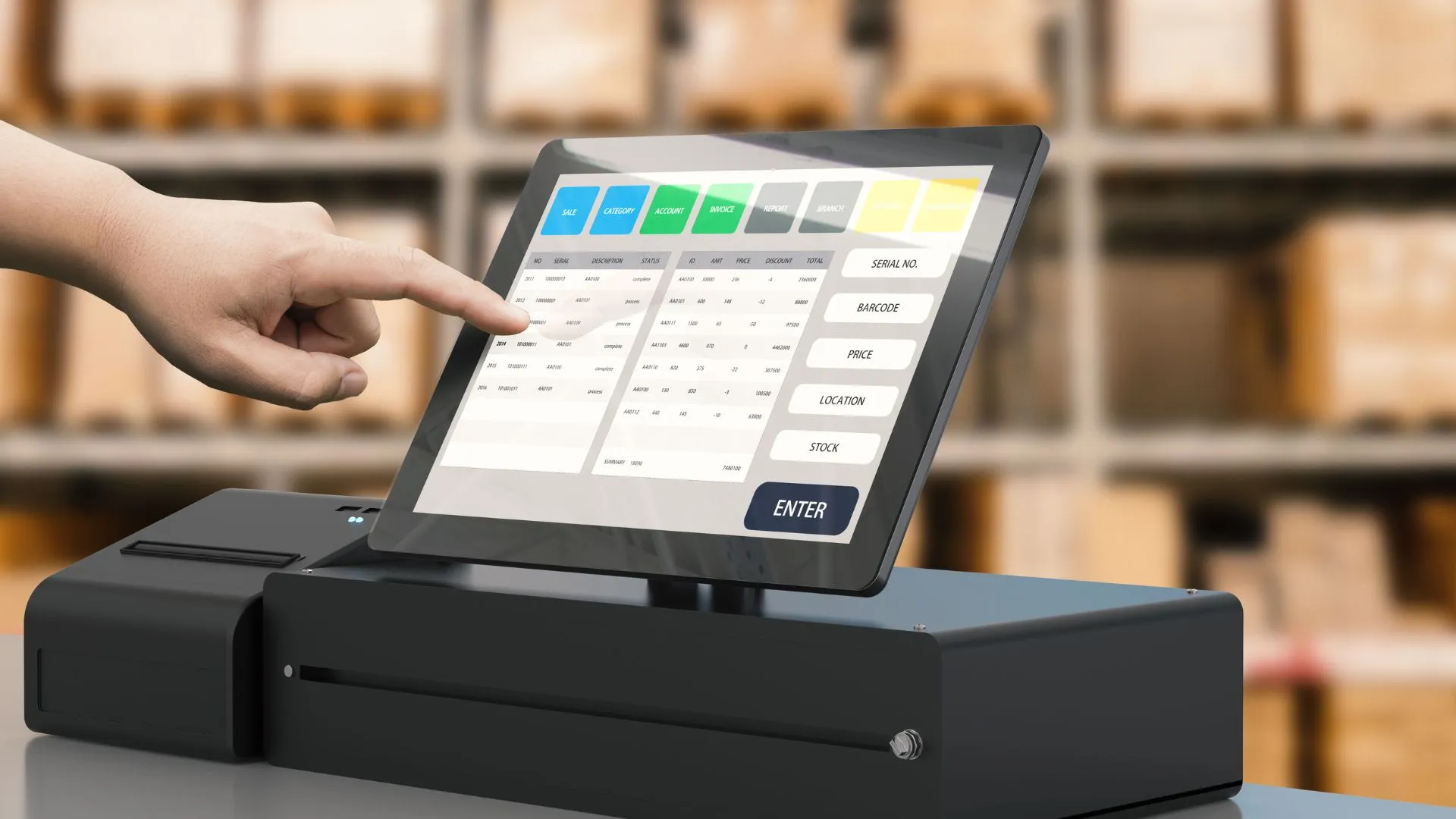Cloud Integration Platforms Guide: Top 10 Solutions for SMBs and Large Enterprises
In today’s digital-first environment, businesses are increasingly dependent on a broad variety of applications, from customer relationship management (CRM) systems to financial software.
Small-sized businesses, medium-sized companies, and even large enterprises share the need for an efficient and streamlined software and IT infrastructure.
And as the number of software you use increases, it can be hard to keep up.
That’s where Cloud Integration Platforms come into play.
By using the right Cloud Integration Platforms, you can seamlessly connect all of your software applications.
Without systems integrations—such as Cloud Integration Platforms—businesses are prone to:
- Low Efficiency and Lack of Automation: Operating in an environment with multiple, unintegrated systems lowers overall efficiency and increases the risk of error.
- Duplicate Data Management: One of the most taxing issues is managing identical data sets across different systems, such as customer information. This not only doubles the workload but also introduces serious risks to data consistency and accuracy.
- High Maintenance Costs: The manual effort needed to export and import data between systems or manage these platforms concurrently can disrupt workflow efficiency. This, in turn, leads to soaring costs and increased payroll expenses for administrative staff tasked with managing these cumbersome processes.
- Security Vulnerabilities: Disjointed systems pose substantial security risks for businesses, particularly those in regulated industries such as financial services. The potential for data loss, theft, or cybercrime increases in environments lacking streamlined integration
Table of Contents – In this post, we’ll cover:
- What Are The 3 Major Data Integration Methods?
- What Are Cloud Integrations?
- How Are Point-To-Point Integrations Different From Cloud Integrations?
- How Is And Enterprise Service Bus (ESB) Different From Cloud Integrations?
- What are the Benefits of Cloud Integrations?
- What Are the Limitations Of Cloud Integrations?
- What Makes A Great Cloud Integration Platform?
- What Are The Different Categories Of Cloud Integration Platforms?
- Top 10 Cloud Integration Platforms
- How To Start Using Cloud Integrations
Let’s dive in.
What Are The 3 Major Data Integration Methods?
As a business owner, you have several options for integrating and organizing your data. Selecting the right method is crucial to meet your specific business needs.
The three primary data integration methods include:
- Cloud integrations
- Point-to-point integrations
- Enterprise service bus (ESB)
What Are Cloud Integrations?
Cloud integrations are strategic technological solutions that enable seamless communication and data sharing between cloud-based applications and on-premises systems. They facilitate a unified, efficient workflow across diverse IT environments.
By leveraging cloud integrations, businesses can enhance operational efficiency, improve data accuracy, and drive innovation through real-time data synchronization and automated processes, making it an essential component for modern digital transformation strategies.
Cloud integration platforms:
- Offer a blend of scalability and flexibility.
- Can adapt and expand alongside business growth
- Can connect team members anywhere, anytime, on almost any device with a dynamic IT infrastructure.
Cloud Integrations are ideal for: Businesses of all sizes, from startups to large enterprises, that can connect both cloud-based services and on-premises applications.
They are the best choice for fast-growing companies that need to scale quickly, integrate new apps, and monitor real-time data.
Most cloud integration platforms also come loaded with pre-developed connectors backed with thousands of combinations, so you can start building integrations right away.
Some businesses that may benefit from cloud integrations include:
- SaaS Providers: Companies offering software as a service that need to integrate their product with various other cloud services used by their customers.
- Online Education Platforms: Services providing online courses that need to integrate payment gateways, content management systems, and customer support tools.
- Digital Health Services: Healthcare providers offer telemedicine services. Patient management systems are integrated with cloud-based diagnostic and communication tools.
How Are Point-To-Point Integrations Different From Cloud Integrations?
Point-to-point integrations directly connect two systems for straightforward data exchange, whereas cloud integrations act as middleware to facilitate scalable, flexible communication between multiple applications across cloud and on-premises environments.
- Ideal for simple setups with few systems.
- Can become overly complex and hard to manage as the number of connections grows.
- Similar to a direct phone line between two people; efficient for small-scale operations but clunky when more lines are added.
Some examples of point-to-point integrations in different types of businesses include directly linking:
- Order Processing to Shipping Software: An online retailer integrates their order processing system directly with their shipping vendor’s software to automate the shipping process, ensuring orders are promptly dispatched once they are received.
- Website Leads to CRM Software: A small business uses point-to-point integration to automatically transfer leads captured from their website forms directly into their Customer Relationship Management (CRM) system for immediate follow-up.
- Inventory Level Updates Between Supplier and Retailer Systems: A boutique clothing store directly connects its inventory management system with its main supplier’s system to automatically update stock levels, ensuring the store can reorder popular items before they run out.
- Employee Time Tracking to Payroll System: A consulting company integrates its employee time tracking software directly with its payroll system to streamline payroll processing, ensuring accurate and timely employee payments based on the hours worked.
- POS System to Accounting Software: A café integrates its Point of Sale (POS) system directly with its accounting software to automatically update sales data and financial records, simplifying financial reporting and tax preparation.
How Is Enterprise Service Bus (ESB) Different From Cloud Integrations?
An Enterprise Service Bus (ESB) acts as a centralized hub to manage communications and integrations within complex IT environments, while cloud integrations provide a more flexible, scalable approach to connect disparate systems across cloud and on-premises setups.
- Best suited for complex environments that require intricate integrations.
- Offers advanced routing, data transformation, and more.
- Requires senior-level integration architects with professional integration experience—which you can find at Euvic.
- Need expert guidance to be as agile as cloud integrations, potentially slowing down adaptation in fast-changing business landscapes.
ESB Integrations are ideal for: Large enterprises with complex and varied IT systems needing robust integration solutions. They are particularly effective in environments where there are many different types of systems and applications, including legacy systems that need to communicate seamlessly. ESB integrations are the go-to choice when centralized management of integrations and high-volume data processing are critical for business operations.
Some businesses that may benefit from ESB solutions include:
- Government Agencies: Public sector entities requiring integration of internal systems with external services for data sharing, regulatory compliance, and public services delivery.
- Financial Institutions: Banks and insurance companies that need to integrate customer relationship management systems with transaction processing, compliance reporting, and risk management software.
- Manufacturing Companies are corporations that manage a global supply chain, integrating logistics, inventory, and procurement systems across various locations.
Want a team of proven experts to help you handle your complex software integrations? Get a risk-free consultation with over 18 years of integration experience now.
What are the Benefits of Cloud Integration Platforms?
There are a number of benefits to leveraging cloud integrations over other integration methods. Some of the most potent benefits of cloud integrations include:
- Operational Efficiency: Automate tasks and processes for faster, error-free operations.
- Scalability: Easily adjust to your business’s growing needs without overhauling your IT infrastructure.
- Enhanced Decision Making: Access to real-time data across platforms aids in making informed decisions swiftly.
- Cost Savings: Businesses can significantly cut costs by optimizing resource use and reducing the need for multiple disparate systems.
- Improved Customer Experience: Ensure consistent and up-to-date data across all customer touchpoints.
- Comprehensive Connectors: Access to various connectors for popular applications and services, simplifying the integration process across different platforms.
- All-in-One Capabilities: This solution offers a unified solution that combines data integration, API management, and process automation in a single platform, reducing the need for multiple tools.
- Out-of-the-Box Ease of Setup: Many cloud integration platforms come with pre-configured settings and intuitive setup wizards, allowing for quick deployment and minimal technical expertise required to get started.
What Are the Limitations Of Cloud Integration Platforms?
While cloud integrations offer numerous advantages, there are certain considerations to bear in mind:
- Regulatory and Data Ownership Concerns: For regulated industries like finance and banking, or any sector handling sensitive personal data, the use of cloud services can present significant challenges. Strict regulations may prohibit the use of certain cloud services due to concerns over data ownership and the inability to maintain full control over where and how data is stored and processed.
- Complexity in Selection: The abundance of available platforms can make the selection process challenging, necessitating careful consideration to find the right fit.
- Integration Challenges: Integrating legacy systems with cloud-based platforms may require additional effort to ensure seamless functionality.
- Dependence on Internet Connectivity: Similar to other cloud-based solutions, cloud integrations rely on consistent Internet access to function, which could be a limiting factor in the event of connectivity issues.
What Makes A Great Cloud Integration Platform?
While there are countless cloud integration platforms to choose from, there are a few core features that you should look for when picking your own. When searching for the best cloud integration platform for you, make sure to consider the following:
- Core Integration Capabilities: A great platform’s core capability is its ability to connect a wide array of applications effortlessly. This includes a comprehensive library of pre-built connectors to popular business applications and services, ensuring that you can integrate your existing systems without hassle.
- Custom Integration Support: Every business has unique needs, sometimes requiring specialized solutions. An ideal platform offers the flexibility to develop custom integrations for niche or legacy systems, enabling you to tailor the integration process to your specific requirements, all without necessitating extensive coding expertise.
- Real-Time Data Synchronization: In today’s fast-paced business environment, the ability to access and act on real-time data is paramount. A top-notch cloud integration platform facilitates immediate data exchange, empowering you to make swift, informed decisions and maintain operational agility.
- User-Friendly Interface: Complexity should never be a barrier to efficiency. A user-friendly interface, characterized by intuitive design and ease of navigation, makes the platform accessible to technical and non-technical users, democratizing cloud integrations across your organization.
- Visual Workflow Builders: The inclusion of drag-and-drop and visual programming features streamlines the setup and management of integrations. This not only simplifies the integration process but also allows for quicker adaptation and implementation of workflow changes.
- Scalability and Flexibility: As your business evolves, so too should your integration platform. An exceptional platform can scale up or down in response to business growth or changing needs without requiring significant reconfiguration.
- Flexible Pricing Models: The best cloud integration platforms understand that businesses come in all sizes and stages of growth. Therefore, they offer a range of pricing options. This ensures that you can select a plan that matches your current needs while accommodating future expansion.
- Robust Security Measures: Protecting your data is non-negotiable. Adherence to global data protection standards and the implementation of secure data transmission methods safeguard your information against unauthorized access and breaches.
- Comprehensive Support and Documentation: Access to a robust support network, including customer service across multiple channels and extensive resources like tutorials, forums, and user guides, enhances your experience and ensures you can maximize the platform’s benefits.
- Advanced Features for Complex Integrations: For businesses with intricate integration requirements, advanced features such as API management and AI capabilities can offer the sophisticated solutions needed to navigate complex scenarios.
- Longevity and Future-Proof Features: The ideal platform demonstrates a history of success and a commitment to long-lasting integrations. It should have a solid track record of consistent updates, innovation, and a roadmap for future development.
- Industry-Specific Solutions: It’s essential to evaluate how a cloud integration platform aligns with the specific use cases and challenges within your industry or business vertical. A platform that caters to the unique requirements of your sector, with proven use cases and success stories from similar businesses, can offer more targeted workflows for your needs.
- Terms, Conditions, and Contracts (Vendor Lock-In): Always read the fine print. Numerous platforms will have the potential for vendor lock-in clauses—especially on larger contracts. Opt for providers that offer transparency and flexibility in their contracts.
In sum, a great cloud integration platform is one that not only meets your current integration needs but also anticipates your future challenges, providing the tools and support necessary to foster a seamless, efficient, and secure digital ecosystem for your business.
See how forward-thinking companies are advancing their industries with enhanced IT infrastructure.
What Are The Different Categories Of Cloud Integration Platforms?
There are two main categories of cloud integration platforms. Each serves distinct business needs and offers specific advantages. Understanding these categories’ differences could save you and your team valuable time and energy.
On-Premise and Self-Hosted Solutions
For businesses that prioritize control over their integration tools and data, on-premise and self-hosted solutions are a compelling choice. These platforms are installed and run on your company’s own servers, giving you complete oversight of security, data management, and compliance with industry regulations.
This level of control is especially important for organizations in sectors with stringent data protection standards. However, this option requires a commitment to managing and maintaining your IT infrastructure, which can be resource-intensive and may pose challenges for smaller operations.
iPaaS (Integration Platform as a Service)
iPaaS stands out for its flexibility, scalability, and ease of deployment.
These cloud-based solutions offer a comprehensive approach to integration, combining a vast array of connectors with the convenience of cloud hosting. An iPaaS platform enables seamless communication between diverse applications, whether in the cloud or on-premises, without additional hardware or extensive setup.
This model is particularly attractive for agile businesses seeking to adapt quickly to changing integration needs without the heavy upfront investment associated with on-premise solutions.
The choice between on-premise/self-hosted platforms and iPaaS will largely depend on factors such as your organization’s size, industry-specific requirements, security concerns, and the scalability of your integration needs. By carefully weighing these options, you can ensure you select a cloud integration platform that aligns with your current operations and supports your future growth ambitions.
Top 10 Cloud Integration Platforms
To help you navigate the options, we’ve curated a list of the top 10 cloud integration platforms that stand out for their robust features, scalability, and industry reputation.
These platforms have been selected based on their ability to streamline operations, foster seamless communication between applications, and drive digital transformation across various business needs.
Whether you’re looking to enhance operational efficiency, integrate disparate systems, or ensure data consistency across your organization, these top contenders offer the tools and capabilities needed to achieve your goals.
Top iPaaS Cloud Integration Platforms
1. Workato
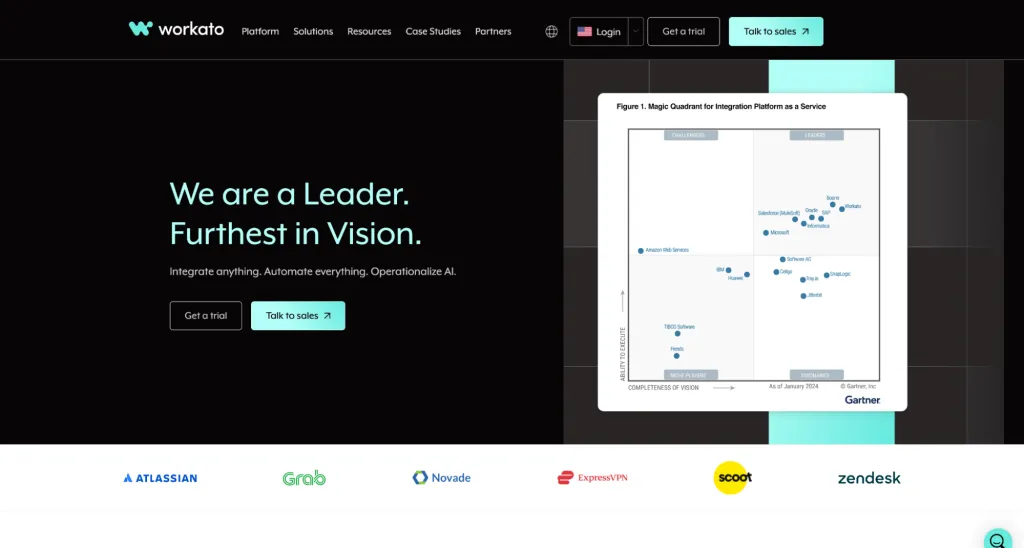
Description: Workato distinguishes itself as a leading iPaaS cloud integration platform, recognized for its extensive range of pre-built connectors with out-of-the-box capabilities and its user-friendly no-code/low-code interface that empowers both technical and non-technical users.
Workato prioritizes enterprise-grade security and compliance, ensuring data protection across all integrations. Workato offers features such as data encryption, audit trails, and compliance with regulations like GDPR, HIPAA, and SOC 2. This makes it a reliable platform for businesses concerned with maintaining the highest standards of data protection and privacy.
Features: Robust automation, over 1,000 pre-built connectors, automation for over 300 enterprise programs, and AI-driven insights.
Pros: Highly customizable, user-friendly interface.
Cons: May be costly for small businesses.
Pricing: Starts at $10,000/year.
Best for: Mid-sized to large companies focused on extensive automation and integration.
2. Microsoft Azure

Description: Azure Integration Services by Microsoft offers a cohesive suite of tools for building comprehensive integration solutions. With a strong focus on security, scalability, and flexibility, it enables seamless data flow across cloud and on-premises environments, catering to the needs of businesses aiming for digital transformation. Microsoft Azure offers unparalleled scalability and integration within the Microsoft ecosystem, making it an ideal choice for businesses deeply embedded in Microsoft’s suite of products and services.
Features: Easy automation, workflow creation, AI, analytics, database management, a global network of data centers, and robust security measures.
Pros: Deep integration with Microsoft ecosystem; scalable and secure.
Cons: Requires a significant amount of expertise to leverage effectively.
Pricing: Offers both fixed and pay-as-you-go pricing models to match business needs.
Best for: Enterprises of all sizes leveraging Microsoft’s ecosystem for complex integration needs.
3. MuleSoft Anypoint Platform

Description:MuleSoft’s Anypoint Platform provides a comprehensive solution for API-led connectivity, enabling businesses to connect apps, data, and devices anywhere, on-premises or in the cloud. Its emphasis on API management and connectivity makes it a powerful tool for creating a seamless digital fabric across the enterprise.
Features: Wide-ranging API and integration capabilities; support for numerous protocols and standards.
Pros: Highly scalable, strong enterprise and API management features.
Cons: Steep learning curve, higher cost.
Pricing: Requires a custom quote.
Best for: Large enterprises requiring extensive, complex integrations across multiple environments.
4. Dell Boomi

Description: Dell Boomi offers an integrated cloud platform to connect applications, data, and people, facilitating efficient business processes. Its intuitive interface and vast range of connectors simplify the integration process, making it accessible to businesses of any size.
Features: Unified platform for integration, API management, extensive connector library, and workflow automation.
Pros: Multiple integration options, strong support and community, sleek interface.
Cons: Learning curve for new users.
Pricing: Custom pricing based on usage.
Best for: Medium to large businesses seeking comprehensive integration solutions with strong support for legacy systems.
5. Jitterbit
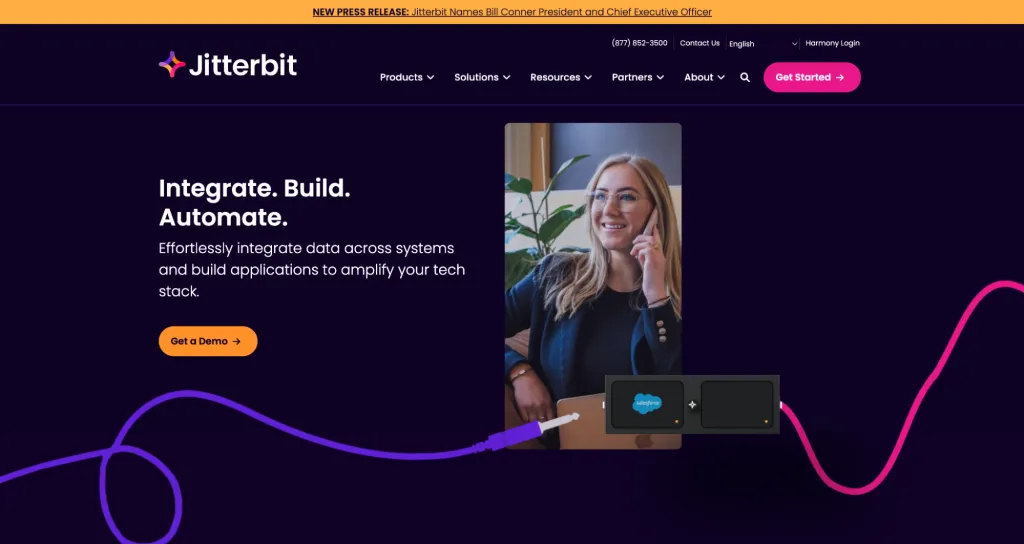
Description: Jitterbit is an API transformation and integration platform that enhances the capabilities of cloud services, SaaS, and on-premises applications. It stands out for its ease of use and powerful automation capabilities, designed to boost efficiency across various business processes.
Features: Data integration, API transformation capabilities, and process automation.
Pros: User-friendly, strong customer support.
Cons: Custom connectors may require additional work.
Pricing: Custom pricing.
Best for: Businesses of all sizes looking for a powerful yet accessible integration platform.
Top On-premise and Self-hosted Integration Platforms
6. IBM App Connect
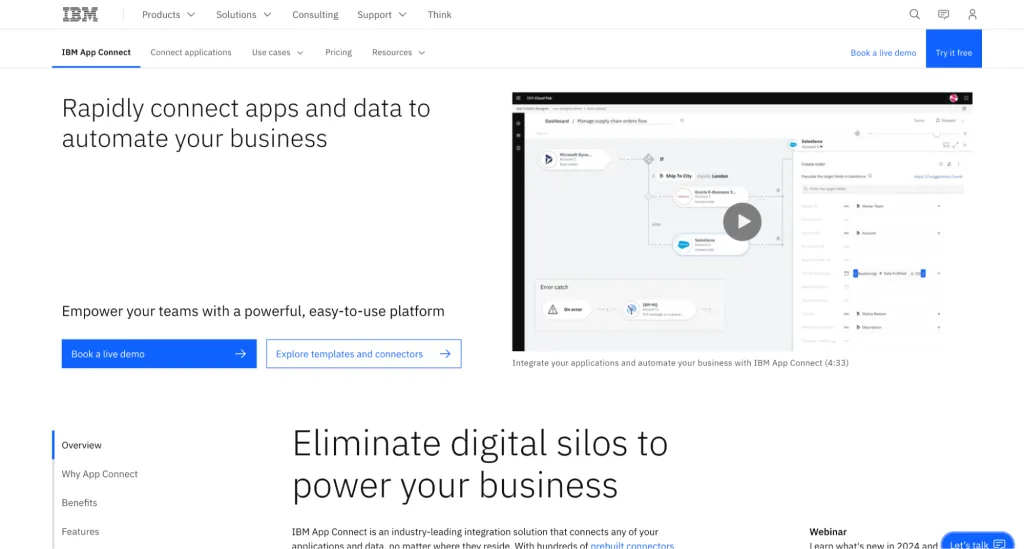
Description: IBM App Connect excels at automating workflows and integrating applications and data across your business. It offers a mix of powerful, straightforward tools for connecting cloud and on-premises applications, making it a strong choice for enterprises looking to enhance their operational agility.
Features: Automation of workflows, integration of apps, data, and AI services.
Pros: High performance, strong enterprise focus.
Cons: Can be costly for smaller businesses and complex for beginners.
Pricing: Starts at approximately $500/month; custom enterprise pricing.
Best for: Medium to large enterprises in need of reliable integration solutions with legacy support.
7. Informatica PowerCenter
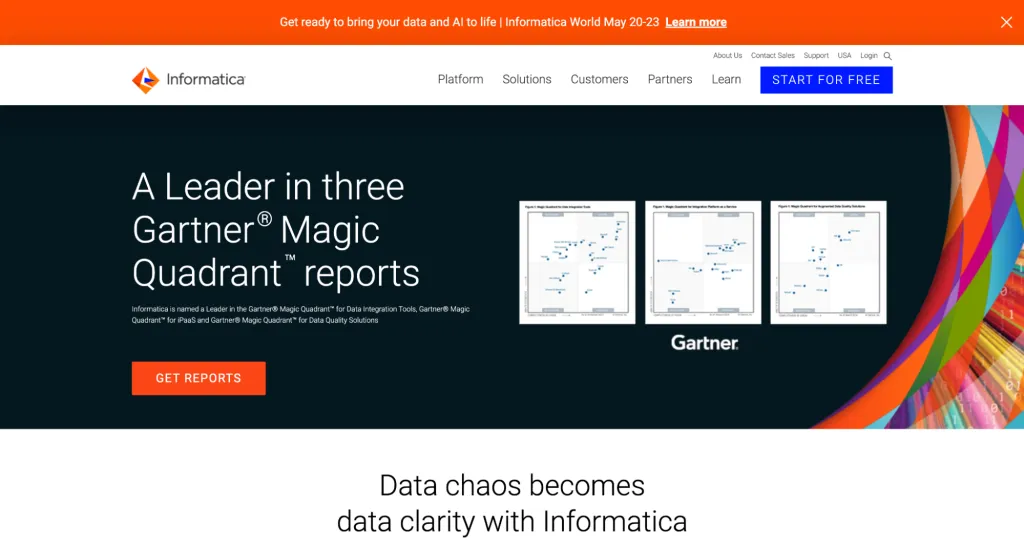
Description: As a leader in data integration, Informatica PowerCenter provides a scalable, high-performance solution for integrating, cleansing, and managing data across systems. It’s designed for businesses that require robust data management capabilities to drive decision-making and operational efficiency.
Features: Data integration, quality, and governance for on-premises, hybrid, and cloud environments.
Pros: Strong data management capabilities, supports large datasets.
Cons: Pricing transparency issues, and complexity for non-technical users.
Pricing: Custom pricing.
Best for: Large enterprises with extensive data integration and management needs.
8. Talend Data Integration
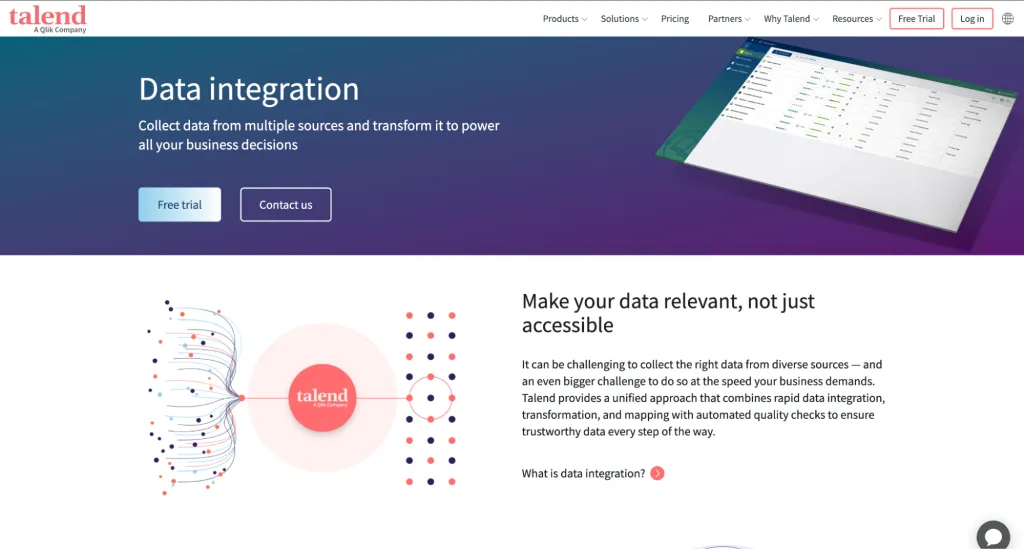
Description: Talend Data Integration offers a suite of cloud and on-premises tools for data integration and management. Known for its open-source foundation, Talend makes advanced data processing and integration accessible, supporting a wide range of big data and cloud environments.
Features: Comprehensive suite for data integration, quality, and governance across cloud and on-premises.
Pros: Wide range of powerful tools, open-source version available.
Cons: Can be complex, steep learning curve for the full suite.
Pricing: Open-source version is free; commercial versions have custom pricing.
Best for: Businesses seeking flexible, powerful data integration tools, from startups to large corporations.
9. Oracle Integration Cloud
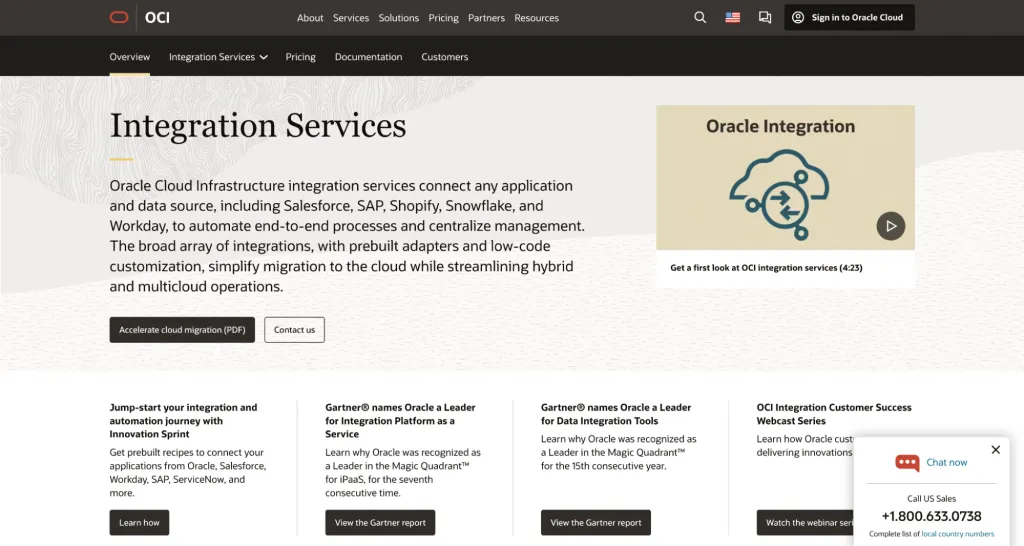
Description: Oracle Integration Cloud simplifies the process of connecting your applications, automating processes, and creating a more connected enterprise. It offers deep integration with Oracle’s suite of products and a broad set of capabilities for streamlining business processes.
Features: Broad set of integration capabilities, including process automation and API management.
Pros: Deep integration with Oracle products, strong enterprise capabilities.
Cons: Pricing can be high and may be complex for non-Oracle environments.
Pricing: Custom pricing.
Best for: Medium to large businesses, especially those already using Oracle products.
10. Microsoft BizTalk Server

Description: Microsoft BizTalk Server is an on-premises server for business process automation, integration, and EDI. It’s tailored for businesses that require sophisticated on-premises integrations, offering a wide range of tools for connecting disparate systems.
Features: On-premises server for business process automation, EDI, and integration.
Pros: Strong integration with Microsoft products and extensive enterprise support.
Cons: Focus on on-premises can be limiting and complexity in setup and management.
Pricing: Pricing varies, requires a license purchase
Best for: Medium to large enterprises deeply embedded in the Microsoft ecosystem and requiring on-premises integration solutions.
How To Start Using Cloud Integrations
The right cloud integration platform can significantly advance your business by enhancing operational efficiency and ensuring seamless customer experiences. But, embarking on this journey requires a thoughtful approach, from identifying your integration needs to selecting the platform that aligns perfectly with your business goals.
Here’s how you can get started with cloud integrations:
- Identify Your Integration Needs: Start by assessing your current software applications and identifying key areas where data and process integration could eliminate silos and streamline workflows.
- Take A Deeper Look At Specific Cloud Integration Platforms: Explore the different categories of cloud integration platforms – iPaaS and On-Premise/Self-Hosted solutions – to determine which aligns with your business requirements.
- Evaluate Platform Features: Consider the essential features of a great cloud integration platform, including integration capabilities, user-friendly interface, scalability, and security measures. Match these features against your specific business needs.
- Trial and Test: Many cloud integration platforms offer trial periods or demo versions. Take advantage of these to test the platform’s ease of use, integration capabilities, and compatibility with your existing systems.
Make The Most Of Your Integration Platform With Euvic
Navigating complex IT infrastructures and integration platforms can be challenging. Without a deep level of expertise in the IT field, it’s easy to find yourself overwhelmed by the myriad of options and technical nuances.
This is where Euvic steps in as your trusted partner, bringing over 18 years of experience to the table. We specialize in making the intricate world of cloud integrations accessible. From evaluating potential platforms to implementing sophisticated integration strategies, our team is committed to ensuring your IT infrastructure is not just operational but optimized for peak performance.
Choosing Euvic means opting for a partnership that values your business’s growth and efficiency. Our approach is designed to minimize the risk of vendor lock-in, ensuring you maintain flexibility and control over your digital landscape.
With our proven Euvic Integration Framework, we provide a clear roadmap to selecting the best cloud integration solutions, complete with pre-built connectors and seamless execution strategies. Don’t let the complexities of cloud integration hold your business back.
Schedule a risk-free consultation with Euvic today to discover how our service can simplify your IT challenges, allowing you to focus on what you do best: growing your business.
Euvic is a competitive advantage for us. The technical excellence that Euvic has brought is not easily matched and their support has become integral to our growth strategy.

Euvic is a competitive advantage for us. The technical excellence that Euvic has brought is not easily matched and their support has become integral to our growth strategy.

Euvic is a competitive advantage for us. The technical excellence that Euvic has brought is not easily matched and their support has become integral to our growth strategy.

Talk to Your Local Euvic Team

















.webp)














